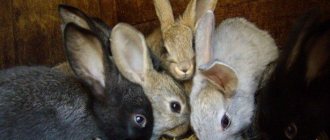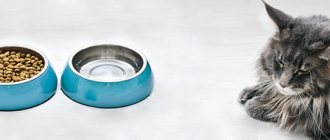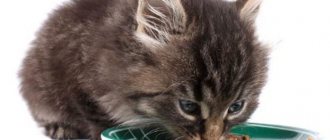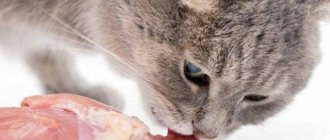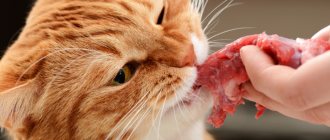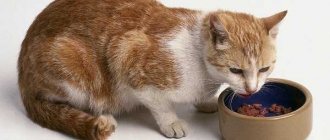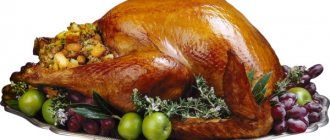10421Administration
The question of whether it is possible to feed a cat raw meat seems strange to many owners, because everyone knows that these pets are predators by nature, and no one cooks for animals in their natural habitat. In fact, a cat's intestines are perfectly adapted to process raw meat, however, it can be dangerous for the pet. Especially often, when feeding raw meat, health problems arise in show purebred cats, in which, for the sake of external appearance, little attention is paid to health, and kittens already have certain disorders at birth.
Meat is necessary for cats, as it is their main natural food. Raw meat is the best food for cats. To ensure that this product does not harm the animal, every owner must know exactly how to prepare it for giving to the pet. If everything is done correctly, then the meat will only benefit the cat and will not cause any problems to its health. Don’t forget to give your kitten raw meat, thanks to which it will develop fully.
© shutterstock
What kind of raw meat is suitable for a cat?
Raw meat in a cat's diet is important for its growth and development.
Cats are carnivorous animals and in normal, undomesticated life they would consume raw meat, attacking small animals and birds. Meat is the main source of protein for the rumbling savage, a source of growth, strength and development. Therefore, we can conclude that feeding your cat raw meat is acceptable and even healthy.
Both animal muscle tissue and offal, that is, the internal organs of animals and birds, can be used as a meat diet.
Cats and cats can be fed the following types of meat:
- Beef, which should not form the main diet of the animal, as it is harder to digest than poultry or rabbit meat. But it has a beneficial effect on the animal’s body, both the meat itself and the offal.
- Rabbit meat. It has a small amount of fat and is considered dietary. The animal's body easily digests any part of the rabbit. An animal cannot be allergic to it.
- Chicken/turkey. The most popular poultry meat in the diet of cats, it contains little fat, the meat is well digestible, both breast meat and meat from drumsticks and thighs. However, unscrupulous producers often use chemical additives and substances when breeding birds, which manifest themselves in the animal as an allergy when consuming their meat. In this case, it is necessary to refuse poultry meat or replace it with farm chickens and turkeys.
- Mutton. You can use their meat in small quantities in lean parts of the carcass. But the pet often refuses lamb because of the specific smell.
- Horsemeat is more nutritious than beef and also contributes to the diet of an animal that has gained extra pounds.
- Mouse meat can be fed to domestic cats only in purchased form, since wild mice and rats can be sources of various infections and viruses.
It is advisable to feed cats poultry, rabbit, beef and lamb.
For a normal and balanced diet, meat from various animals and birds can be combined or a new type of meat can be served every week.
It was also allowed to give raw meat to a kitten after it refused mother's milk. It is better to add boiled or stewed meat to the complementary feeding of a natural diet kitten at the age of 3-4 weeks from birth, but if you refuse mother's milk at the age of 8 weeks, you can switch the animal to raw meat.
Important: an adult cat needs 100 grams of meat per day.
Acceptable by-products
It is recommended to feed predators not only meat, but also animal by-products
The following can be used as by-products in your pet's diet:
- Heart of pig, beef and poultry. It is a source of the acid necessary for the animal’s heart – taurine.
- Beef, rabbit and poultry liver. It is advisable to serve it in combination with other products.
- Chicken, turkey and rabbit stomachs, which are sources of vitamins.
- The necks, heads, and cartilages of birds help the animal clean its teeth and get the right amount of calcium.
- It is advisable to use animal lungs in the diet of kittens, as they promote growth and development. They are less nutritious for older cats.
The majority of the animal's diet should be the heart and stomachs (up to 40%). The remaining by-products are used in combined form up to 5-10% of the total diet.
What types of meat are the healthiest?
Healthy low-fat meats for cats
The most preferred, nutritious and safe for feeding a cat is poultry (chicken or turkey), rabbit, as well as horse meat and beef. They contain the least amount of fat and the most protein. Poultry and rabbit meat are well and quickly absorbed by the animal's body.
If possible, poultry meat should be purchased outside of stores, since store-bought meat may contain various chemical additives and cause allergies in your pet. Chicken contains the most protein per 100 grams of meat, and chicken breast is the highest in calories.
Many veterinarians report the dangers of cats eating domestic chicken, so replace it with turkey if possible. The danger is associated with the content of bacteria and parasites in chicken meat, which can infect a cat.
Beef should not be used as the main diet, as it is harder and longer for the predator to digest.
To avoid bacteria and parasites entering the animal’s body when feeding raw meat, the meat must be frozen for about one week at a temperature below 20 degrees.
Prohibited species
You shouldn't feed your cat pig meat.
It is better to completely exclude pig meat from the cat’s diet, as it contains a large amount of fat, which interferes with the normal absorption of protein by the animal. It is unacceptable to feed your pet pork if the cat has diseases of the digestive and genitourinary systems or is obese.
In addition, pig meat contains parasite larvae - Trichinella, which can survive even freezing or heat treatment of meat.
It is also not allowed to feed the animal any kind of smoked, salted or fried meat.
In particular, you should not feed your animal raw game meat, as it contains a high content of parasites and bacteria.
Fish meat
You can feed only boiled sea fish no more than once a week
Predators don't eat fish because they don't have the opportunity to catch them. Therefore, considering fish as the natural diet of cats is a mistake.
It is permissible to use sea fish to feed cats, but only boiled, without bones and internal organs, and no more than twice a week.
Green light for the chicken!
The food of any pet, including cats, especially if it is still small, must be balanced. Sometimes such balancing can be achieved if you feed your pet high-quality industrial food. As a rule, this is Premium class food. But such pleasure can cost a pretty penny, and therefore many cat owners prefer to feed their pets natural homemade food, or, as a last resort, combine homemade food with industrial food (but for some breeds this is not acceptable).
So, if the owner decides to prepare food for the pet himself, then along with other meat products, is it possible to feed the kitten chicken and chicken by-products, because, you see, today chicken remains the most affordable and accessible type of meat. A cat needs meat first and foremost.
So, chicken can be given to kittens and adult cats almost every day, but not fried, but boiled and definitely WITHOUT bones, especially if it is a small kitten. At 3.5 months, when the baby has grown enough and his teeth have become stronger, you can start feeding him with chicken legs, and by one year - with chicken heads.
But it is better to take the heads of young hens or chicks, they are more tender, their bones are soft, and it is convenient for cats to chew them. It is better to boil both the legs and heads thoroughly so that they become soft. Of course, cats need to be given raw meat sometimes, but not chicken because there is a risk of salmonella infection.
It is best to feed kittens chicken breast - soft meat and without bones. You can give boiled chicken by-products - heart, lungs, kidneys, liver. It should be noted that cats adore liver almost as much as fish, only experts and veterinarians do not advise getting carried away with it (they recommend no more than once a week), because the liver, as is known, is the body’s filter, including in animals, and therefore the coat may become coarser, and in light-haired pets the color may darken. Adult cats and small kittens don’t really like lungs and kidneys; they don’t really eat them. The heart is given 1-3 times a week.
A good option is to grind boiled chicken through a meat grinder and make a kind of minced chicken that can be given to kittens along with broth. This will make it more convenient and easier for the kitten to eat.
The dangers of raw meat products
Raw meat may contain bacteria and parasites
There are dangers in feeding raw meat to your domestic cat. Raw animal meat may contain parasites and infections that can enter the cat's body during feeding.
What you can get infected with:
- Salmonellosis, which can be obtained from chicken, fish and rodents. Salmonella bacteria are more resistant to freezing, but are killed at high temperatures. If infected, your cat may experience vomiting and diarrhea. The bacterium can be transmitted to humans.
- A pet can become infected with toxoplasmosis, which is caused by parasites, from infected raw meat of rodents, birds, or beef. This disease is also transmitted to humans. The infection disrupts metabolism and can disfigure the animal's fetus or lead to its death.
- Listeria bacteria are found in the meat of rodents and birds. Can be transmitted to humans. Affects the nervous system of the body.
- Sarcocystosis, provoked by parasites that can be contained in pig and beef meat. Parasites are resistant to freezing.
Feeding only raw meat is not enough to provide a complete and balanced diet for your pet. The animal's diet should include, among other things, vegetables, cereals, offal, essential minerals, vitamins and antioxidants.
Principles of natural food feeding
When organizing natural feeding of a cat, the main task of the owner is to create a diet as close as possible to the “menu” of the pet in nature. Unlike relatively omnivorous dogs, cats are obligate (obligate) carnivores. They feed on the carcasses of small rodents and birds, obtaining from them all the necessary nutritional elements. They eat several times a day, in small portions. The digestive system of representatives of the cat family is adjusted to this method and type of nutrition.
Meat main component
They are characterized by a protein-fat type of metabolism. The enzymes necessary for the breakdown of carbohydrates in the gastrointestinal tract of predators are not synthesized, therefore, carbohydrates are not absorbed. They are needed in small quantities for normal bowel function.
At home, it is almost impossible to accurately recreate the natural feeding of pets. It is difficult to imagine an owner who would agree to release laboratory mice or birds into the apartment so that the cat could hunt them as needed. Conscientious owners try to artificially bring the cat’s nutrition closer to the ideal.
The first thing you need to decide is how to eat. There are three options:
- Free access;
- serving size limitation;
- time mode.
They all have pros and cons. Feeding with a certain frequency, at a constant time, helps control the amount of food consumed, stabilizes the functioning of the digestive system, and helps prevent obesity.
Free access to food is closer to the cat's natural diet. She can control her “reserves” and feels and behaves more calmly. At the same time, the owner may not immediately notice problems with the cat’s appetite or overeating when feeding this way. This type of meal arrangement is especially dangerous when there are several cats living in the house. The free access method is not suitable for individuals who lack a sense of proportion. There are quite a lot of such cats; they eat the entire portion at once, no matter how large it is, and then quickly gain excess weight.
Toyger cats, description, history of the breed, photos and price in rubles for kittens
Pets with such eating habits should be given a limited amount of low-calorie, fiber-enriched food. If there is no possibility of constant control, it is better to feed the cat according to the schedule.
Clean water should always be available. Cats are desert animals and have less need for fluid, but it is necessary for normal kidney function.
This is interesting: How much food to give a cat
How to secure meat before feeding
To destroy bacteria and parasites, it is necessary to freeze the meat before feeding the cat.
Some parasites and bacteria contained in meat products of animals and birds can be killed by freezing above 20 degrees from 24 hours to one week. Also by boiling meat. However, some nutrients disappear during cooking, for example, taurine, which is necessary for the health of the animal.
It is important to monitor the quality of meat products and their expiration dates. Do not allow your pet to feed leftovers, scraps or spoiled meat.
It was better to purchase meat from local livestock and chicken breeders.
It is necessary to store meat used to feed a cat at a temperature no higher than 5ﹾC and serve the animal the amount that it will consume at one time, so that the leftovers do not spoil.
How often to feed meat, and in what quantity?
There should be up to 80% of the total diet of meat products per day.
In order to determine the amount of meat products in a cat's diet, it is necessary to take into account factors such as the animal's age, breed, health, activity and even its gender.
Of the total diet of raw meat, adult cats and cats can use 60% to 80% of the total amount of the rest of the food. The remaining percentage of natural nutrition includes vegetables, cereals, offal, including necks, cartilage, animal blood and other products.
That is, meat must be given daily. A pet weighing 5 kg eats about 250 grams of food per day. Of these, more than half should be meat, that is, depending on weight - from 100 to 200 grams per day for a cat is the norm.
Kittens up to one year old are fed four to six times a day. Adult cats can be fed 2-3 times a day.
The meat is served sliced. It is not recommended to feed prepared minced meat. It is allowed to make minced meat yourself. By eating meat fiber, the animal assimilates it better.
In this case, it is advisable to serve offal 1-2 times a week. Liver should be given once a week.
How to give: the best recipes
It is useful to give your pet boiled breast with carrots and broccoli.
Cat owners recommend preparing the following simple chicken dishes for natural-fed pets:
- Chicken with vegetables. The breast is boiled and chopped. Add steamed broccoli and carrots in equal proportions. Then a small amount of fresh broth is introduced.
- Liver with garnish. Finely boil and chop 400 g of offal with the addition of 2 tbsp. l. olive or sunflower oil. Add 200 g of steamed oatmeal and 50 g of steamed green peas.
- Kidneys in sauce. Boil and chop 200 g of chicken kidneys. Add 4 tbsp. l. prepared oatmeal and ¼ cup grated carrots. Melted butter of medium fat content - 30 g is poured on top. Then 70 ml of yogurt without additives is added.
- Nutritious breakfast. Boil 70 g of rice. It is better to use unrefined, as it improves intestinal motility. Combine 1 boiled chicken egg in one plate, 1 tbsp. l. chopped carrots and boiled green beans and 20 g of chopped chicken fillet. 3 tsp is introduced. olive fruit oils.
If your cat previously ate exclusively dry food, raw chicken may not be of interest to her. Veterinarians advise boiling it and adding treats that your pet loves.
For babies and older cats, veterinarians recommend placing cooked food in a blender to facilitate digestion and prevent constipation. It is not enough for cats to eat meat in its pure form; the menu must be supplemented with sources of carbohydrates and fiber - bran, vegetables or fruits.
Combining raw and cooked meat
It is not recommended to feed both raw and cooked meat at the same time.
Boiled meat does not worsen the pet's health, but when cooked, meat loses most of its beneficial nutrients. Including the digestion of boiled meat is more difficult for animals than raw meat. Since the cat’s body uses different enzymes and time for digestion to digest cooked and raw meat, feeding both types of meat at the same time will have a serious impact on the stomach.
Feeding raw and cooked meat at the same time is not recommended due to the strain on the pet's digestive system.
Veterinarian's comment
Raw meat is physiologically closer to cats. This means that eating a piece of fresh, clean and safe meat will definitely not make your furry pet feel bad.
However, the chicken sold in the store may be stale, raised in questionable conditions and on unhealthy feed. Therefore, at a minimum, raw chicken meat needs to be soaked and thoroughly frozen.
The second aspect is that chicken bones have a tubular structure. When chewed, they break into very sharp fragments. And this is a danger of mechanical damage to the digestive organs. If the animal is not quite young, then it is better to refuse raw chicken with bones.
As for - chicken meat is the safest in this regard. At least if you choose between chicken and fish, it is better to give preference to birds.
Pet owners often wonder about their pet's nutrition. What can you offer a cat as a treat without harming their health? Should you feed your pet only food, or can you give him something from your table? For example, a fragrant piece of raw meat, or, on the contrary, boiled? Today we will look at all possible options.
Meat for castrated and sterilized
Spayed and neutered cats and female cats are prone to weight gain
Spayed and neutered male cats have decreased activity and decreased metabolism. They are more likely to gain excess weight. Accordingly, they need less protein. A high protein content in their diet can cause obesity and other diseases of the internal organs. It is necessary to reduce not only the level of protein, but also fats and carbohydrates.
Therefore, the amount of meat in their diet must be reduced and served once a day.
The amount of feed after such surgical interventions is reduced to 150-250 grams per day. At the same time, use lean types of meat about 60-70% of the total diet.
Is it possible to give raw meat to small kittens?
Kittens can also be fed raw meat.
At the age of 3-4 weeks, the kitten begins to be introduced to complementary foods, and it begins with dairy products and cereals. Gradually, his diet begins to include meat products in boiled or processed form.
At the age of two months, when the kitten completely switches to homemade food and refuses mother's milk, he can be given finely chopped raw poultry, beef, rabbit and lean lamb, as well as high-quality offal of these animals.
Kittens up to 3-4 months are fed up to 6 times a day. In 3-4 times it is important to include boneless meat. Beef should be given up to 30 grams per day, and poultry 3-4 times a week. During the day, the weight of meat products should be 10% of the kitten's weight.
By-products should be fed to the kitten 1-2 times a week.
It is important to ensure that the meat is of high quality, purchased from trusted places. It must be served after thoroughly freezing.
Is food sold in pet stores irreplaceable?
Nutrition for a kitten is undoubtedly important for its growth and health. But do not forget that small kittens are not able to eat dry food, since their stomach is not yet prepared for this. For this reason, in the initial stages they are fed with warm milk, cream and sour cream.
Solid foods are gradually added to the diet
.
For example, tidbits of meat from a bag for feeding cats up to a year old, and some mustachioed representatives even eat vegetables and bread. But they should not be given frequently and should not be used as the main source of nutrition. Some owners give their pets fresh meat rather than canned meat. Such as pieces of chicken
, both raw and cooked. Not to mention various sausages.
After a year of life, cats themselves begin to take a closer look at the food offered. Some people no longer eat dry food as actively, wanting to get a double portion of cream or sour cream. And it happens the other way around. The animal is not interested in either meat or fish. Just food and nothing more.
But also, representatives of the feline species begin to observe for themselves what you personally eat. For example, standing at the table and cutting yourself sausage into sandwiches, you notice out of the corner of your eye how a cat looks at you pleadingly, sniffing the smell. Well, how can we resist here?
When cutting off a piece and giving your cat a meat product to try, you must understand that he may not like it. Or maybe exactly the opposite.
There is even a kind of sign. If a cat eats a piece of sausage or sausage, then this product is suitable for you to eat and there is no point in worrying. But most people don't think it's right to use their animal as a guinea pig, so they don't give anything from their table.
Undoubtedly, dry food can be replaced as a constant food. But whether the animal will stand in solidarity with you is another question. It is believed that cats and cats are quite picky about food, and it is difficult to please them. But this does not apply to all felines. This mainly depends on the breed and the character of the animal itself. And also on what you teach him to do from an early age. Be it regular food, or special food that you come up with for him yourself. Some owners prepare real dishes for their furry household members. And we're not talking about scraps of meat in a bowl. No. They boil full pieces of meat, both chicken and fish, and then mix it with porridge. This is a kind of food that is sold in stores, but homemade. This way you completely monitor your animal’s diet.
Is it possible to feed a cat only meat?
In addition to meat, the cat should eat vegetables, grains and dairy products
For normal and proper development of the body and health, any animal needs a balance of proteins, fats and carbohydrates. Meat alone cannot provide a cat with all the nutrients and substances important for its body.
Meat products should make up up to 80% of the total diet, and the rest of the diet consists of a combination of vegetables, cereals, fermented milk products such as cottage cheese, natural yogurt, unsalted cheese.
In the wild, cats, when hunting, eat their prey not only in pure meat form, but also eat cartilage, fiber, and blood. They also eat herbs and vegetables.
Eating only meat can lead to elemental deficiency, gastrointestinal diseases, disease of the animal's thyroid gland and calcium deficiency and, as a result, brittle bones.

